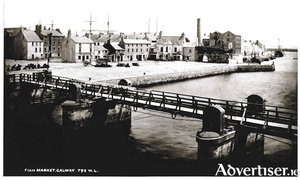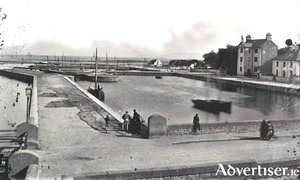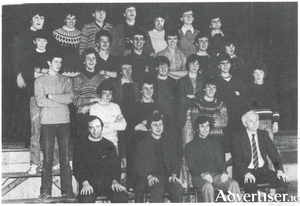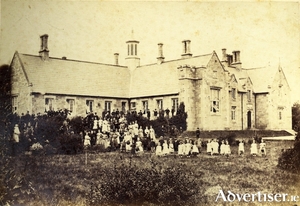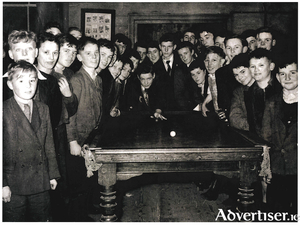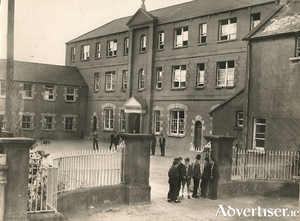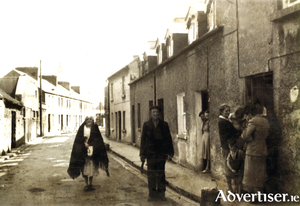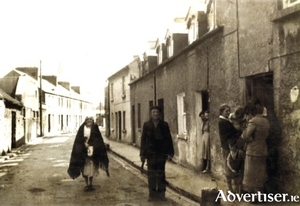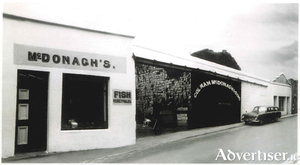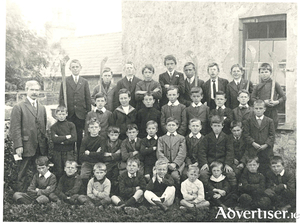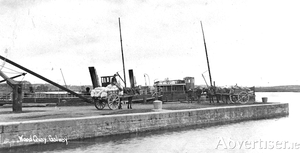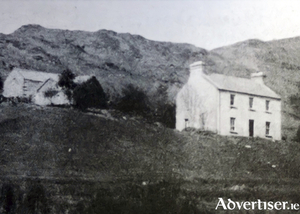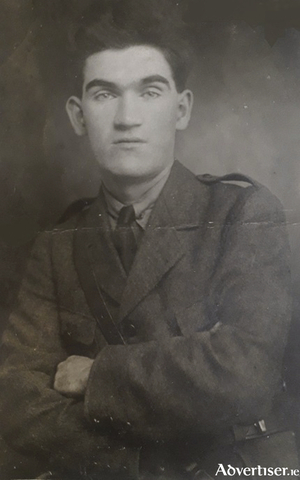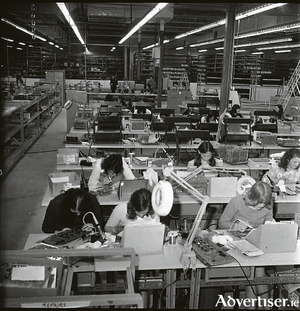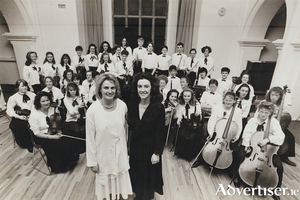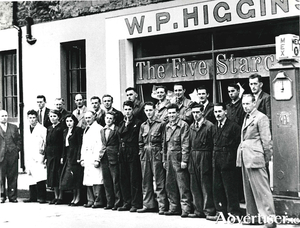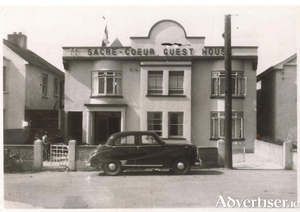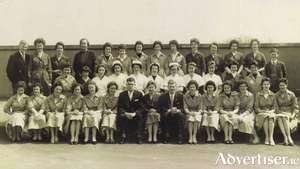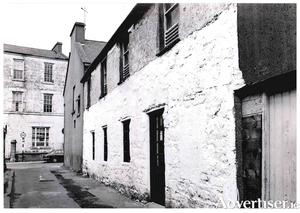Wolfe Tone Bridge
Thu, Jul 28, 2022
Wolfe Tone Bridge was the third bridge to be built over the river. The West Bridge (now known as O’Brien’s Bridge) was the first and dates from medieval times. The Salmon Weir Bridge dates from 1820, and the Wolfe Tone Bridge was built in the mid-19th century.
Read more ...The construction of the Claddagh Basin
Thu, Jul 21, 2022
On January 1, 1848, Samuel U Roberts was appointed district engineer of the Districts of Lough Corrib. He spent the early part of that year making necessary preparations and arrangements and started navigational works in Galway on March 8, having taken possession of some of the lands required for the Eglinton Canal.
Read more ...The class of ‘82
Thu, Jul 14, 2022
One hundred and sixty years ago, in 1862, the Jesuits opened the doors of St Ignatius' College on Sea Road for the first time. They also opened a community residence and a church at the same time. To take on such an ambitious building project at a time when the economic state of the country was so bad took courage and vision.
Read more ...The Model School
Thu, Jul 07, 2022
The Model School on Newcastle Road was built in 1849/50 for a cost of £2,533 plus £800 for the furniture. It was one of a series of Model Schools built around that time and was the only one constructed under budget. It opened in July 1852, 170 years ago this month. It catered for Protestant children.
Read more ...The Boys' Club
Thu, Jun 30, 2022
“There is nothing as Galway as Our Lady's Boy’s Club,” was how our president Michael D Higgins described OLBC some years ago at a function in the Columban Hall. It is more than 80 years since it was founded and it is the longest-running youth club in the country. It was set up by Fr Leonard Shiel SJ at a time when there were was a lot of grinding poverty in Galway and no recreational facilities or extra-curricular activities for young people in areas like the Claddagh, Bohermore, Shantalla, and ‘The West’. The club provided these and has been a source of guidance and inspiration to thousands of young men and boys since, especially those from a working class background. From that first day of nervous membership, right through their teens, and even after they had taken up the challenges of adult life, the spirit and watchful eye of the Club is ever with them.
Read more ...The Boys' Club
Wed, Jun 29, 2022
“There is nothing as Galway as Our Lady's Boy’s Club,” was how our president Michael D Higgins described OLBC some years ago at a function in the Columban Hall. It is more than 80 years since it was founded and it is the longest-running youth club in the country. It was set up by Fr Leonard Shiel SJ at a time when there were was a lot of grinding poverty in Galway and no recreational facilities or extra-curricular activities for young people in areas like the Claddagh, Bohermore, Shantalla, and ‘The West’. The club provided these and has been a source of guidance and inspiration to thousands of young men and boys since, especially those from a working class background. From that first day of nervous membership, right through their teens, and even after they had taken up the challenges of adult life, the spirit and watchful eye of the Club is ever with them.
Read more ...The Bish
Thu, Jun 23, 2022
The Patrician Brothers, at the invitation of the last Catholic Warden of Galway, arrived in Galway in 1826 and a month later they opened St Patrick’s Monastery and School on Market Street. They initially had 200 pupils but this figure rapidly grew so that during the Famine, there were more than 1,000 boys being educated, fed, and many of them clothed there every day. The school was a major success but there were no educational facilities for older boys in the ‘lower orders’ in Galway so Bishop McEvilly invited the Patrician Brothers to set up a secondary school.
Read more ...Sickeen/Suckeen
Thu, Jun 16, 2022
According to O’Donovan’s Ordnance Survey Letters from 1839, “Suckine is now pronounced Suicín, which is, out of satirical humour frequently called Suicín na Mallacht, that is “Sickeen of the Imprecations or Curses”. It is written Sickeen Dyke in the Name Book and described as lying where the road from Galway to Menlo crosses the flooded land at Coolagh.”
Read more ...Sickeen/Suckeen
Wed, Jun 15, 2022
Sickeen/Suckeen
According to O’Donovan’s Ordnance Survey Letters from 1839, “Suckine is now pronounced Suicín, which is, out of satirical humour frequently called Suicín na Mallacht, that is “Sickeen of the Imprecations or Curses”. It is written Sickeen Dyke in the Name Book and described as lying where the road from Galway to Menlo crosses the flooded land at Coolagh.”
McDonagh’s, a Galway treasure
Thu, Jun 09, 2022
Patrick McDonagh from Galway was born in 1817 and married Sarah Cooney. They had a son Michael who married Peggy Wallace in 1870, and they in turn had a son Colman in 1875. He had a habit of whispering in people's ears and so became known as ‘Cogar’. In 1902, he moved from Carraroe to Galway and rented stores at the back of the Spanish Arch from Peter Greene. From there, he began to sell coal, carrying it on a horse and cart.
Read more ...Bohermore and some of its people
Thu, Jun 02, 2022
On the 1651 map of Galway, Bohermore is shown as running from The Green (Eyre Square) to the present Cemetery Cross where the ‘Old Gallows’ was located. There was also a gallows ‘where justice is executed’ near the Green. To the left and right of Bohermore, the land was known as St Bridget’s Hill and the region around Prospect Hill was known as Knocknaganach (Cnoc na Gaineamh), the Sandy Hill.
Read more ...Steamer’s Quay
Thu, May 26, 2022
Alexander Nimmo made a survey of Lough Corrib almost 200 years ago in which he wrote the following: “The lake has 50 miles of shore, occupies 30,000 Irish acres and contains 1,000 acres of arable land in its isles, and contracts into a very spacious river about two and a half miles above Galway, which, flowing by the town, communicates with the Atlantic. The fall from the summit of the lake to the sea is considerable, but to the Wood Quay, above the town, it is trifling, and the river is in parts very shallow, running over a bed of rocks and hard gravel. It is not navigable from the sea to the Wood Quay owing to its shallowness and the rapidity of the water, and none but small boats can come down; but unless in very dry seasons, it is thence navigable by boats drawing four feet of water and carrying from ten to twenty tons, with one square sail and four men, to Cong. They seldom sail, unless before the wind, and though the lake has many islets and sunken rocks, the only serious difficulty in navigation is at Buachally Shoal about four miles up the lake, and at Newcastle. These shoals could be deepened for a small sum and the whole made to admit vessels of much greater magnitude. The fine navigation which extends about 30 miles, and into a seaport town, seems to deserve more attention than it has yet received. A good chart with soundings and sailing instructions should be published, the shoals or rocks cleared or beaconed, and a communication opened with the sea.”
Read more ...The legend of the last battle in Connemara
Thu, May 19, 2022
During the war of Independence the West Connemara IRA brigade, under the command of Petie McDonnell, was an effective and disciplined force. It had moved its headquarters to the Muintir Eoin residence of Pádraic Mór Ó Máille, a two-storey farmhouse, backed by rock and heather covered hills, which stood on a small rise, along the Maam to Leenane road. It offered commanding views of the Maam Valley.
Read more ...A night of terror
Wed, May 11, 2022
In November 1920, Jimmy Folan, aged 20, of O’Donoghue Terrace, Woodquay, was sentenced by court martial to six months imprisonment with hard labour for acting as a republican policeman and possessing seditious documents – one of which blamed the local RIC for the killings of Seamus Quirk and Seán Mulvoy. Having served his time, he was released on May 10, 1921. That evening, a benevolent RIC sergeant warned a local volunteer to tell Jimmy ‘not to be at home tonight’.
Read more ...Digital Equipment Corporation, fifty years in Galway
Thu, May 05, 2022
In May 1971, it was reported that US computer manufacturer, Digital Equipment Corporation (known here simply as DEC) had chosen Galway for its first hardware manufacturing base in Europe because of the availability of an English speaking workforce, a favourable tax policy, a local university, and the anticipated entry of Ireland into the EEC.
Read more ...The Galway Youth Orchestra, forty years
Thu, Apr 28, 2022
Years ago, there was neither an independent community orchestra nor a musical instrument teaching system in Galway city or county. A handful of schools, mostly run by religious orders, taught a small range of instruments and would put a small orchestra together for their annual school show or operetta, their music teachers being very influential in passing on a love of music to their pupils.
Read more ...Higgins’ Garage
Thu, Apr 21, 2022
In 1912, WP Higgins, working from his base in Athenry, went to Cork city to meet Henry Ford to ask him for the Ford dealership. It marked the start of a great business partnership between a business legend and Higgins' Garage.
Read more ...The Sacre Coeur Hotel, the early years
Thu, Apr 14, 2022
My earliest memory of Jim was of him building his house near us in Salthill. He had a small corrugated iron shed he lived in while working there. We local working men, all of us about six or seven years old, decided he needed a hand, so we went to “help” him, moving sand and mixing cement, etc. We were obviously a complete distraction and a nuisance but he was a gentle man. He would sit us down beside his shed, give us a slice of bread and jam, and then frighten the life out of us telling us ghost stories. A very nice way of getting rid of us at the same time as vastly improving the efficiency level of the amount of work being done on site.
Read more ...A new shopping experience in Galway – Woolworths
Thu, Apr 07, 2022
The expansion of the Woolworth chain in Ireland in the early 1950s proceeded smoothly except in one location, Galway. A number of city councillors, supported by some local retailers, were against bringing new business into town. Eventually, Woolworths purchased the site of the old Royal Hotel in the Square. The hotel was demolished and a new purpose built retail store constructed in its place. When Woolworths advertised for staff, more than 500 girls applied. Officials of the firm were very taken aback and it took several days to complete the interviews. The weekly wage offered to the girls, £4 7s 6d, was very good for the time. About 50 people were initially employed.
Read more ...From Crooked Lane to Church Lane
Thu, Mar 31, 2022
On a 1625 map of the city, this lane is referred to as ‘Crooked Lane’ and a little later in that century, it was commonly known as ‘Céim Cam’. In 1708 it was referred to as ‘Church Lane’ and on two documents dated 1824 it is down as ‘Bohercranmore’ (the Lane of the Big Tree) and also as Church Lane, sometimes called Lána an Teampaill. During the last century it was locally known as ‘O’Gorman’s Lane.
Read more ...